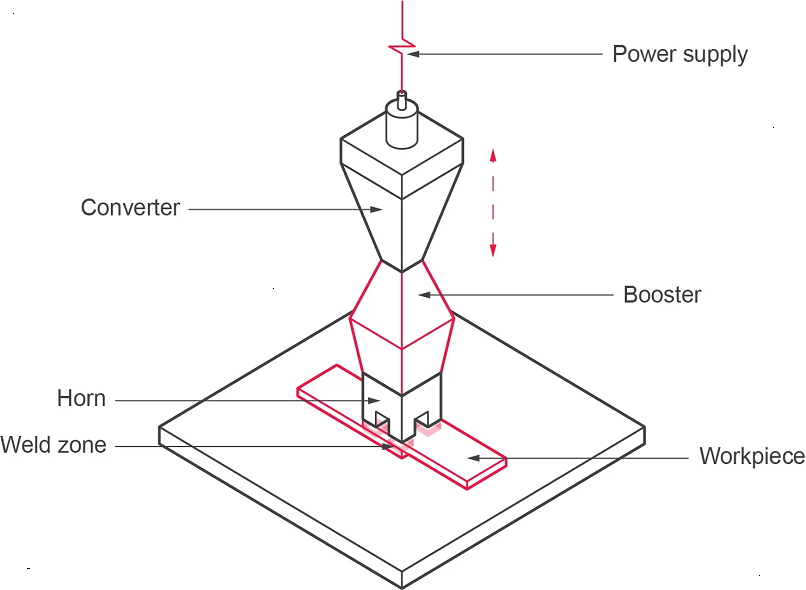Understanding Ultrasonic Welding Plastics

Plastic is an essential material in our daily lives, from food containers to electronic devices. It's crucial to ensure the strength and integrity of plastic products in various industries, and ultrasonic welding is one of the most efficient and precise ways to achieve this. In this comprehensive guide, we'll explore the intricate process of ultrasonic welding plastics, including its principles, equipment, steps, advantages, and applications.
Ultrasonic welding is a widely used process in various industries for joining two plastic parts. It's a solid-state welding process that uses high-frequency ultrasonic vibrations to create strong, reliable bonds between plastic components without the need for adhesives or additional materials. The process is fast, efficient, and precise, making it a preferred choice for various applications.
How does Ultrasonic Welding Plastics work?
Ultrasonic welding plastics is a specialized subset of the broader ultrasonic welding technique, tailored specifically for joining plastic materials. The basic principles of ultrasonic welding plastics involve the conversion of electrical energy into mechanical vibrations, which are then used to generate heat and create a bond. Here's a step-by-step breakdown of the process:
1. Material Preparation:
Before the actual welding process begins, prepare the plastic components to be joined. This involves ensuring that the surfaces to be bonded are clean, flat, and free of contaminants. Proper preparation is crucial for achieving strong welds.
2. Clamping:
Securely clamp the plastic components together in a fixture or between a horn (also known as a sonotrode) and an anvil. The clamping ensures that the parts remain in close contact throughout the welding process.
3. Vibration Application:
The heart of the ultrasonic welding plastics process lies in the transducer, which contains piezoelectric crystals. When an electrical voltage is applied to these crystals, they rapidly expand and contract, creating high-frequency ultrasonic vibrations, typically in the range of 20 kHz to 70 kHz.
4. Heat Generation:
The ultrasonic vibrations are transmitted through a booster, which amplifies their amplitude, and then through the horn to the plastic components. As the horn contacts the plastic parts, it applies pressure, causing the materials to vibrate. These vibrations create friction at the interface between the parts, generating heat.
5. Weld Formation:
The heat generated by friction softens the plastic materials at the joint interface, causing them to fuse together. The pressure applied by the horn ensures that the materials are in intimate contact, allowing the bond to form. As the vibrations continue, the softened materials meld together, creating a solid, homogenous weld.
6. Cooling:
Once the welding is complete, the vibrations stop, and the weld cools rapidly, solidifying the bond. Cooling may be further assisted by compressed air or other cooling methods.
7. Unclamping:
After the weld has cooled and solidified, release the clamping force, and remove the newly joined plastic assembly.
This process creates a robust, permanent bond between the plastic components without the need for adhesives or additional materials. It's crucial to note that the success of ultrasonic welding plastics depends on factors like the choice of plastic materials, joint design, welding parameters, and equipment precision.
Materials Suitable for Ultrasonic Welding Plastics
Ultrasonic welding plastics is most suitable for thermoplastics, which are materials that soften when heated and harden when cooled. Common thermoplastics used in this process include:
- Polyethylene
- Polypropylene
- Polyvinyl chloride (PVC)
- Acrylonitrile-butadiene-styrene (ABS)
- Polycarbonate
- Nylon
The compatibility of materials is a crucial consideration in ultrasonic welding plastics. Both materials being joined must be thermoplastics or at least have a thermoplastic component for a successful weld.
Equipment for Ultrasonic Welding Plastics
Ultrasonic welding plastics requires specialized equipment designed to generate and control high-frequency vibrations. The key components of an ultrasonic welding system for plastics include:
1. Transducer:
The transducer converts electrical energy into mechanical vibrations. It contains piezoelectric crystals that expand and contract rapidly when an electrical voltage is applied, generating ultrasonic vibrations.
2. Booster:
The booster is a mechanical amplifier that increases the amplitude of the vibrations generated by the transducer. It ensures that the vibrations are powerful enough to create a strong weld.
3. Horn (Sonotrode):
The horn, often custom-designed for a specific application, transmits the mechanical vibrations to the plastic components being welded. It plays a critical role in controlling the welding process's amplitude and frequency.
4. Anvil:
The anvil provides support for the plastic components being welded and helps define the shape of the joint.
5. Control System:
An essential part of the equipment is the control system, which allows operators to adjust and monitor key welding parameters, such as amplitude, duration, and pressure. This control ensures the precision and consistency of the welds.
Steps in Ultrasonic Welding Plastics
Ultrasonic welding plastics involves a series of carefully orchestrated steps to achieve a successful weld. Here's a detailed breakdown of the process:
1. Material Preparation:
- Ensure that the plastic components are clean and free of contaminants.
- Position the components in the welding fixture or between the horn and anvil.
2. Clamping:
- Securely clamp the plastic components together, ensuring that they are in close contact.
3. Vibration Application:
- Power up the ultrasonic welding equipment.
- The transducer generates high-frequency vibrations.
- These vibrations are transmitted through the booster and the horn to the plastic components.
4. Heat Generation:
- As the horn contacts the plastic components, it applies pressure, causing the materials to vibrate.
- These vibrations create friction at the interface between the plastic components, generating heat.
- The heat softens the plastic materials at the joint interface.
5. Weld Formation:
- The pressure applied by the horn ensures that the plastic components remain in intimate contact.
- As the vibrations continue, the softened plastic materials meld together, forming a solid, homogenous weld.
6. Cooling:
- Once the welding is complete, the vibrations stop.
- The weld cools rapidly, solidifying the bond.
- Cooling may be further assisted by compressed air or other cooling methods.
7. Unclamping:
- After the weld has cooled and solidified, release the clamping force.
- Carefully remove the newly joined plastic assembly.
Each of these steps is critical in achieving a successful ultrasonic weld in plastics. Precise control of welding parameters, such as vibration frequency, amplitude, and pressure, is essential to ensure a consistent and reliable bond.
Advantages of Ultrasonic Welding Plastics
Ultrasonic welding plastics offers several advantages over traditional welding methods and other joining techniques, which contribute to its widespread adoption in various industries:
1. Speed and Efficiency:
Ultrasonic welding plastics is a high-speed process, often completing a weld in just fractions of a second. This rapidity increases productivity in manufacturing, making it suitable for high-volume production.
2. Precision:
The process is incredibly precise, allowing for fine control over welding parameters. This precision ensures consistent and accurate welds, making it suitable for industries with tight tolerances.
3. Cleanliness:
Ultrasonic welding plastics is a clean process. It doesn't involve the use of adhesives, solvents, or filler materials, which eliminates the risk of contamination. This is essential in industries like medical device manufacturing, where product cleanliness is paramount.
4. Strength:
Ultrasonic welds in plastics are strong and durable. The bond created is often as strong as or stronger than the base materials themselves. This strength is crucial in applications where the integrity of the weld is critical, such as automotive and aerospace components.
5. Energy Efficiency:
Compared to some traditional welding methods that require a significant amount of energy, ultrasonic welding plastics is relatively energy-efficient. This can lead to cost savings and reduced environmental impact.
6. No Consumables:
Ultrasonic welding plastics doesn't require consumable materials like welding electrodes or filler metals. This reduces the ongoing costs associated with the process.
7. Versatility:
Ultrasonic welding plastics can be used with a wide range of thermoplastic materials, making it adaptable to various manufacturing needs.
Applications of Ultrasonic Welding Plastics
Ultrasonic welding plastics is used across a broad spectrum of industries due to its precision, efficiency, and reliability. Some of the key sectors where ultrasonic welding plastics is extensively employed include:
1. Automotive Industry:
- Joining plastic components in car interiors, such as dashboard assemblies and door panels.
- Bonding sensor housings and connectors.
2. Electronics Industry:
- Assembling components like printed circuit boards and wire harnesses.
- Joining plastic parts in the manufacture of consumer electronics.
3. Medical Devices:
- Welding components for medical devices, including syringes, catheters, and filter housings.
- Creating hermetically sealed and contaminant-free bonds in medical equipment.
4. Packaging Industry:
- Sealing and cutting packaging materials, such as blister packs and clamshell containers.
- Ensuring secure, tamper-evident seals.
5. Textile Industry:
- Fabric cutting and sealing.
- Attaching zippers and buttons to garments.
6. Aerospace Industry:
- Joining plastic components in aircraft interiors and exteriors.
- Assembling composite materials used in aircraft components.
7. Toy Manufacturing:
- Assembling plastic parts securely to ensure the safety and durability of toys.
8. Renewable Energy:
- Producing solar panels by connecting solar cells to ensure their efficiency and longevity.
These examples illustrate the versatility of ultrasonic welding plastics across different industries. Its ability to create strong, precise bonds in a clean and efficient manner makes it an attractive choice for a wide range of applications.
Ultrasonic welding plastics is a sophisticated and highly effective method for joining plastic materials. It harnesses the power of high-frequency vibrations to create strong, precise bonds without the need for adhesives or additional materials. Its advantages, including speed, precision, cleanliness, and strength, have made it a preferred choice in industries ranging from automotive and electronics to medical devices and aerospace.
As technology continues to advance, ultrasonic welding plastics is likely to find even more applications and innovations. Its contribution to improving product quality, reducing costs, and increasing manufacturing efficiency cannot be understated, making it a pivotal technique in modern manufacturing processes. Whether you're exploring new possibilities in product design or seeking to enhance the quality and efficiency of your production line, ultrasonic welding plastics is a technique worth considering.





